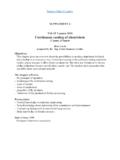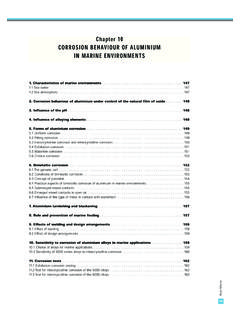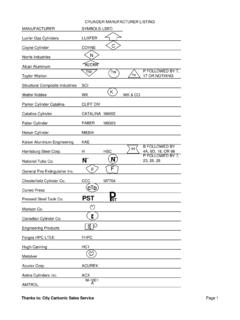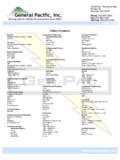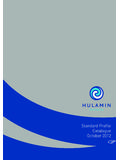Transcription of ALUMINUM FOIL CONTAINERS - afcma.org
1 ALUMINUM FOIL CONTAINERSINTRODUCTION:Background: ALUMINUM is the most widely used non-ferrous metal and is extensively used in packaging materials. It is an excellent material for creating all types of CONTAINERS . However, despite the fact that about seven billion ALUMINUM foil CONTAINERS are produced annually, most packaging engineers and packaging users know very little about the advantages that these CONTAINERS bring to the packaging and food service industries. Specifi cally, ALUMINUM provides an absolute barrier to protect foods, whether on the shelf, in the cooler or in the freezer. It can go from freezer to oven to broiler to microwave oven and result in quality food products whether at home or in central food processing operations. It is lightweight, so that it is easy and economical to transport. It is formable so that it is available in a wide variety of shapes and sizes. It can be printed, coated or embossed. And, it is recyclable which results in a 95% energy savings over that required to produce primary : The objective of this CD is to provide a comprehensive overview of ALUMINUM foil CONTAINERS that will be a suitable educational tool for a wide variety of target Audiences: Current and potential future customers, both industry and consumers Packaging professionals and other decision-makers in the packaging and food service industries Educators at the high school, jr.
2 College and university levels Students, especially those intending to pursue a career in packaging Members of the general public who seek to broaden their knowledge of ALUMINUM packaging productsGeneral Notes to Trainers/Lecturers: Because of the broad nature of the information included in the CD, those using it can mix or match various sections to suit their intended audience. For example, one can cover the general introduction to ALUMINUM and ALUMINUM foil container manufacture in the main body of the disk, or, for more detailed information in ALUMINUM production, click on one of the appendices taken from the TALAT* CD that provide a more in-depth review. Alternatively, a lecture can be made from a single topic, such as ALUMINUM Foil CONTAINERS in Microwave Ovens. Trainers and lecturers are encouraged to utilize those parts of the CD that are suitable to the audience s level of sophistication and interests. (Note: the European spelling and pronunciation of aluminium vs.)
3 The ALUMINUM has been left intact for the documents with European origins. This should not be a cause for concern, but may require an explanation for audiences). *Training in ALUMINUM Application Technologies. Source: TALAT CD-ROM European Aluminium Association, Brussels, 1999 Overview of the ALUMINUM Foil Container Manufacturers Association: The ALUMINUM Foil Container Manufacturers Association (AFCMA) represents leading manufacturers of ALUMINUM foil CONTAINERS in the United States and Canada. The association has worked to promote ALUMINUM foil as a superior packaging material since 1955. (Figure 1) History of ALUMINUM Foil ContainersFormed ALUMINUM foil CONTAINERS were first produced in the late 1940 s for the packaging of bakery products. During the 1950 s there were many innovations and many new uses for formed CONTAINERS . Thus, the industry 1960, nearly 50 million pounds of ALUMINUM were being used to produce formed ALUMINUM CONTAINERS .
4 In the decade from 1960 to 1970, usage grew to 140 million pounds and by 2002 over 250 million pounds of ALUMINUM were used to manufacture over 7 billion CONTAINERS in North America. World wide numbers total over 12 billion CONTAINERS and over 400 million pounds!The growth of the ALUMINUM foil container is due to its many advantages. The natural qualities of ALUMINUM , its impermeability and barrier properties, provide real benefits for consumers. There simply is not a more versatile foil CONTAINERS are formed by combining mechanical and air pressure to force light-gauge ALUMINUM foil into a shaped die cavity. Esthetically appealing ALUMINUM foil CONTAINERS are ideal for table-ready service after the container has functioned first as a package and a heating utensil. Foil CONTAINERS also come in a variety of colors and special purpose foil CONTAINERS are used to prepare, freeze, store, transport, cook and serve a variety of foods. CONTAINERS made from ALUMINUM foil are the only CONTAINERS that can be used in all types of ovens: microwave, conventional, convection and broiler.
5 Moreover, its recyclability makes alumi-num one of the most environment friendly materials on earth, a key advantage for planet conscious consumers and local governments. Additionally, recycled ALUMINUM saves more than 95% of the energy necessary to produce new primary of the major manufacturers of formed ALUMINUM foil CONTAINERS are members of the Alumi-num Foil Container Manufacturers Association. This group is dedicated to producing top quality products and educating the public of the advantages of ALUMINUM foil ALUMINUM foil Container Manufacturers Association (AFCMA) continues to foster the contin-ued growth of this industry with an active education program. This CD-ROM is part of that effort and is intended as a helpful tool for the packaging industry, schools, and 1 Current members of the association include:General members:Alcan Foil Products 416-503-6700 Packaging 800-323-0422 of America (HFA) 800-647-1400 Corporation 800-476-4300 Plate, Inc.
6 800-527-9909 Food Packaging,An Alcoa Business 800-466-3020 Packaging 800-626-2668 Manufacturing Co. 800-456-4119 Supplier members:Alcan Rolled Products 800-743-2875 800-570-7661 Products 800-645-4644 USA, Inc. 800-833-6735 refer to the AFCMA web site for current :The following contributed to the preparation of this educational CD: Dr. Robert F. Testin, Professor Emeritus, Clemson University Training in ALUMINUM Application Technologies. Source: TALAT CD-ROM European Aluminium Association, Brussels, 1999 Member companies of AFCMABRIEF CONTENT DESCRIPTION:SECTION 1: Introduction to ALUMINUM and ALUMINUM Foil Container Production This discussion serves as a basic introduction to ALUMINUM production, ALUMINUM foil production and how ALUMINUM foil CONTAINERS are made. For a more detailed discussion on ALUMINUM and ALUMINUM foil, the reader is referred to the contents of Supplements 1 and 2 for a more detailed description of ALUMINUM and ALUMINUM foil production and to Supplement 3 for a review of the continuous casting process which is the basis for most ALUMINUM foil production.
7 Supplement 4 is a detailed discussion of the ALUMINUM rolling 2: The Perfect Package Advantages of ALUMINUM Foil CONTAINERS ALUMINUM foil CONTAINERS offer the packaging and food service industries and, ultimately, the consumer many advantages. These include its consumer friendliness, tri-ovenability, recyclability, and a comparison of ALUMINUM foil CONTAINERS with other packaging choices. The reader is referred to videos that provide more depth on the use of ALUMINUM foil CONTAINERS in microwave ovens and the container s inherent 3: Foil Container Designs and Applications This section is an overview of the many container designs available in the marketplace. The reader is referred to Supplement 5 for a collage of a number of specifi c ALUMINUM foil CONTAINERS currently in the marketplace. SECTION 4: Current Markets for ALUMINUM Foil CONTAINERS In this section, the dramatic growth of ALUMINUM foil CONTAINERS over the past ten years is discussed. Current markets and market shares for ALUMINUM foil CONTAINERS are 5: Future Markets for ALUMINUM Foil ContainersIn this section, the growth potential for ALUMINUM foil CONTAINERS in the and worldwide is reviewed.
8 The drive toward consumer convenience and fresh and fresh-like foods in the and the compatibility of ALUMINUM foil CONTAINERS for all types of ovens indicates continued strong growth in the markets. The potential overseas growth of ALUMINUM foil CONTAINERS in both developed and developing nations is virtually unlimited. GENERAL TABLE OF CONTENTSS ection 1: Basic Introduction to ALUMINUM and ALUMINUM Foil Container ProductionSection 2: The Perfect Package Advantages of ALUMINUM Foil ContainersSection 3: Foil Container Designs and ApplicationsSection 4: Current Markets for ALUMINUM Foil ContainersSection 5: Future Markets for ALUMINUM Foil ContainersSupplement 1: Introduction to ALUMINUM and light metal Source: TALAT CD-ROM European Aluminium Association, Brussels, 1999 Supplement 2: Resources and production of ALUMINUM Source: TALAT CD-ROM European Aluminium Association, Brussels, 1999 Supplement 3: Continuous Casting Source: TALAT CD-ROM European Aluminium Association, Brussels, 1999 Supplement 4: Rolling: The Process and the Product Source: TALAT CD-ROM European Aluminium Association, Brussels, 1999 Supplement 5: Montage of Typical ALUMINUM Foil CONTAINERS in the MarketVideo 1: The Use of ALUMINUM Foil CONTAINERS in Microwave OvensVideo 2.
9 Recycling of ALUMINUM Foil ContainersSECTION 1: Basic Introduction to ALUMINUM and ALUMINUM Foil Container ProductionIntroduction: ALUMINUM is one of the most abundant metallic elements, accounting for over 8% of the earth s crust on a weight basis (Figure 2). However, economically recoverable ALUMINUM exists in concentrated ore form in only limited locations. The most common, and currently the only commercially utilized ALUMINUM ore, is bauxite. Bauxite may contain 50-60% ALUMINUM oxide (Al2O3) on a weight basis. Bauxite is generally found at or near the earth s surface with most deposits located between the Tropic of Capricorn and the Tropic of Cancer. companies currently mine rich deposits of bauxite in West Africa, Western Australia and in the Central America/Caribbean region. Despite its relative abundance, ALUMINUM was the last of the common metallic elements to be produced on a commercial scale. Because the chemical bond between ALUMINUM and oxygen is higher on the oxidation-reduction scale than other common metals, ALUMINUM cannot be freed from oxygen by typical oxidation-reduction reactions.
10 In 1886, at virtually the same time, American Charles Martin Hall and the French scientist Heroult discovered the electrolytic reduction process that frees ALUMINUM from oxygen. ALUMINUM Production: The basic process is shown in Figure 3 and Figure 4. Purifi ed ALUMINUM oxide is obtained from bauxite by the Bayer Process. ALUMINUM metal is produced in the Hall/Heroult reduction cell. In this process, Al2O3 is dissolved in a molten salt (cryolite Na3 AlF6) at temperatures of 900 to 1000 OC. Electric current is passed through the reduction cell which results in oxygen being released at the carbon anodes and molten ALUMINUM being produced at the cathode, underneath the molten salt layer. The ALUMINUM is virtually pure metal, having an ALUMINUM content of or molten ALUMINUM is drawn from the reduction cell and cast into billets, direct chill (DC) ingots or continuously cast into sheet. (Click onto Supplements 1 and 2 for more detailed discussions of the ALUMINUM production process.)
